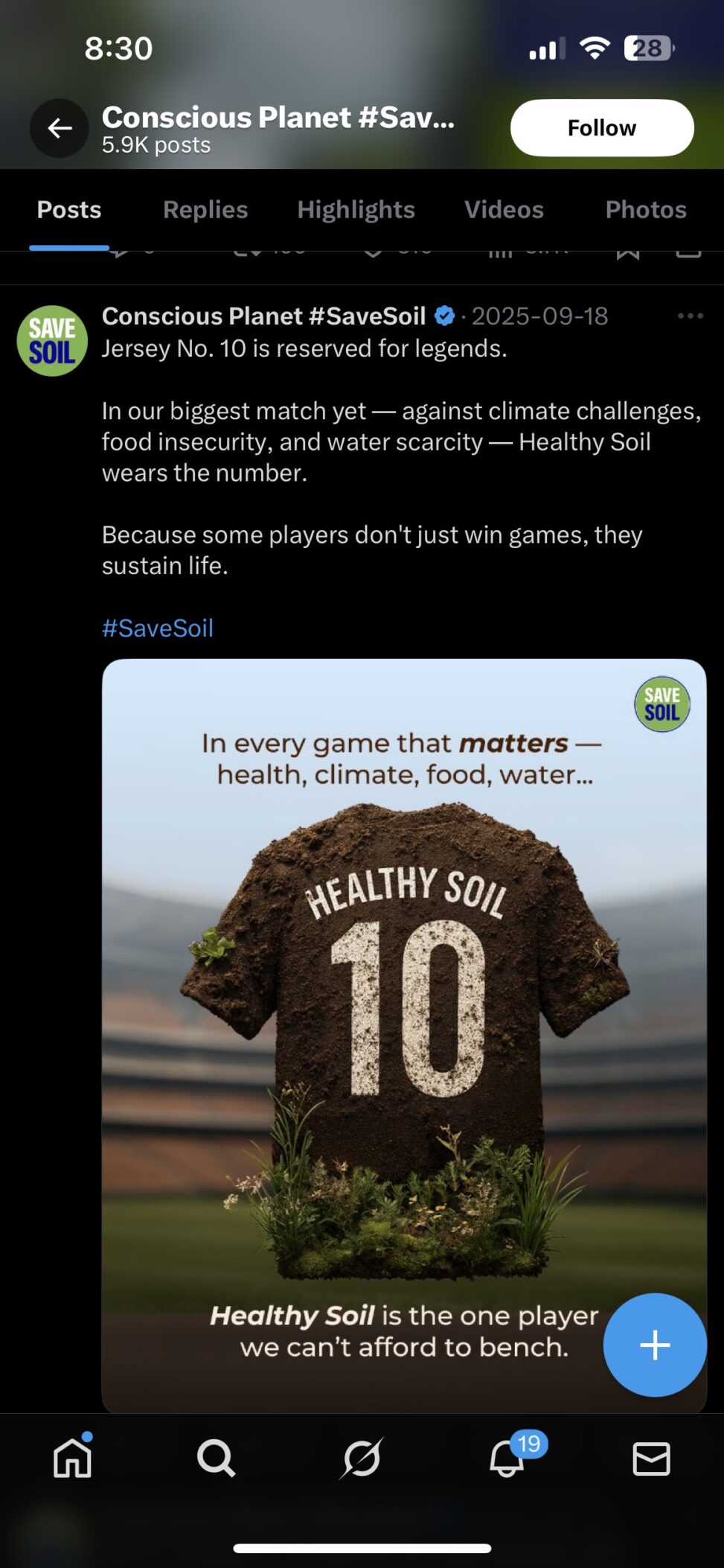#SAVESOIL MOVEMENT
Over the past week, I came across this advertisement from the #SaveSoil movement on Twitter (X). The ad was of a soccer jersey made out of soil with the number 10 on it, which in soccer is usually reserved for the really skilled players. The text read, “Healthy Soil is the one player we can’t afford to bench.” This ad immediately caught my attention because it used sports to pull me in, something known to many people, to deliver a message about soil health; something that might have instead been overlooked. At first glance, it didn’t look like a normal advertisement trying to sell a product. Instead, it came out as a campaign that was trying to spread awareness about an issue that affects everyone knowingly or unknowingly.
The overall message of the ad is clear. Soil is not just dirt that we step on- it is one of the most important foundations of life on Earth. The claim to ecological responsibility has been made by directly linking soil health to major global challenges such as climate change,emphasizes that soil is a vital “player” that we cannot afford to ignore. This claim is supported by real research showing that soil plays a central role in food systems and climate stability. For example, Rakhshan Ummar and Mark A. Bonn explain in their article “Green Social Media Campaigns: Influencing Consumers’ Attitudes and Behaviors” published in Sustainability (2023) that simplified, creative campaigns on social media are often the most effective at shaping how people understand ecological issues. Their study support that visual and metaphorical approaches, like the #SaveSoil jersey, are especially powerful in building awareness and influencing attitudes.
Unlike most ads that try to get you to buy something, this one is selling an idea. It is not asking for money or pushing a product. Instead, it is trying to convince people to care for soil and support its protection. The “purchase” here is symbolic – it is about buying into the movement’s vision of a world where soil health is taken seriously. The ad urges people to support the #SaveSoil campaign, which asks for awareness, conversation, and policy support. In this sense, the ad is trying to change attitudes and behavior of the viewers, not their shopping habits. However, it is important to remember that not all environmental adverts are legit. As Li,Jiaying and Ying’s discusses in the article “Advertising and Corporate Green Innovation: From the Perspective of Greenwashing” published in Sustainability (2024), some advertisements exaggerate environmental claims, which can actually discourage real innovation. However, Wei also makes the point that advertising can have a positive role if it is transparent and focused on advocacy rather than profit. This makes the #SaveSoil ad stand out as more credible, since it does not ask for money but instead tries to raise awareness.
I also recognize that I am part of the target audience for this advertisement. The campaign is clearly designed for people like me; who are active on social media, especially younger generations who are both environmentally aware and highly engaged with digital content. By using the language of sports and celebrity culture, the ad appeals to students, young adults, and anyone who knows about soccer culture. Since I fall into that demographic – being a student who uses social media daily- I fit the campaign’s target audience. The ad assumes its viewers care about global issues and are willing to share their ideas online, and I think that assumption is accurate for me and many of my peers.
Personally, the advertisement appealed to me for a few reasons. The first was the creativity of the image. A soccer jersey made of soil is not something I had ever seen before, and it instantly stood out in my feed. Second, the metaphor made the message simple to understand. Soil can be a hard topic to get people excited about, but by comparing it to a star player with the number 10 jersey, the ad made it something I could relate to as a fan of soccer myself. Third, the ad did not strike me with deep scientific terms or statistics. It focused on one strong image and one short text, which made it easy to remember. The design made me stop scrolling and look at it for a moment, which shows the ad did its job.
I came across this advertisement while scrolling through Twitter on my phone. Seeing it in that space was impressive because social media is full of content, and an ad has to be visually striking to stand out. This one did. It worked because it was more of image-based instead of text-heavy which would have been boring to look at. The soil jersey carried the weight of the message, while the short caption supported it without distracting from the visual. This matches the findings of Ummar, Shaheen, Bashir, Ul Haq, and Bonn in their 2023 study, which shows that simple, visually striking ads can leave a lasting impression and encourage ecological responsibility among audiences.
In conclusion, the #SaveSoil advertisement uses a powerful sports metaphor to make a strong ecological claim: soil health is essential for life. It showcases itself as being socially and ecologically responsible by linking the protection of soil to solving common problems like climate change, food insecurity, and scarcity of water. Instead of encouraging us to buy a product, the ad sells an idea, urging people to commit to protecting soil as if it were a legendary player (number 10) on our team. The ad worked for me because it was visual, simple, and memorable. It also fit me as part of its target audience, since I am a student and social media user who is already interested in environmental issues. While it is important to stay critical and make sure such campaigns lead to real action rather than empty greenwashing, Li,Jiaying and Ying’s 2024 research reminds us that responsible advertising can still play an important role in pushing for environmental awareness. Overall, the #SaveSoil campaign is a strong example of how advertising can be socially responsible while using creativity to communicate ecological values.
Refrences
Ummar, Rakhshan; Kanwal Shaheen; Iram Bashir;
Junaid Ul Haq; and Mark A. Bonn. “Green Social Media Campaigns: Influencing Consumers’ Attitudes and Behaviors.” Sustainability 15, no. 17 (2023):
https://www.mdpi.com/2071-1050/15/17/12932
Li, Jiaying; Ying Fu; and Ying Wu. “Advertising and Corporate Green Innovation: From the Perspective of Greenwashing.” Sustainability 16, no. 23 (2024):
https://www.mdpi.com/2071-1050/16/23/10488


Alessandro Boggio
Shawn Baraza does a great job on describing the subjective side of the image, stating the symbolism of the number 10 jersey in relation to soccer. The objective side of the description is less detailed as it does not cover what is in the background, the colour scheme, nor the plants growing at the bottom of the jersey. Bringing attention to those slight details will heavily influence an audience to think deeper.
Baraza states that this ad sells the ideology of the importance of soil on planet earth. A great academic article is brought in as an example of how consumers behaviours and attitudes are influenced by social media advertisements. This marketing technique is aimed towards younger generations as per the location of the advertisement and the fact that shifting one’s ideology is easily done at a younger age. This piece also covers that “not all environmental adverts are legit” (3). This claim is backed by another academic source that mentions the possibilities of environmental marketing possibly being exaggerated for exposure benefits. Baraza uses a total of two academic sources with no additional sources. This piece is a fantastic subjective breakdown of the advertisement, but the objective analysis could use some deeper thought.